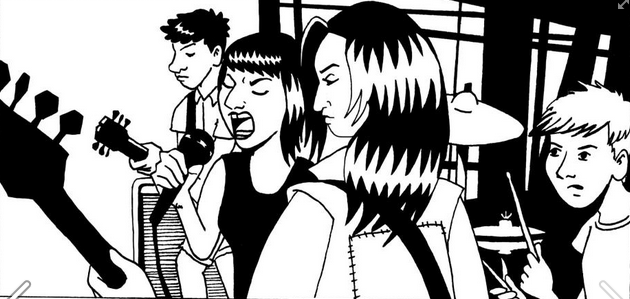 Shady Hawkins, a Brooklyn-based Millennial feminist revengecore band. (Art by cartoonist and Shady Hawkins drummer, Mike Funk)
Shady Hawkins, a Brooklyn-based Millennial feminist revengecore band. (Art by cartoonist and Shady Hawkins drummer, Mike Funk)
The Kids Aren't Alright - But They Might Be
By Alice Lesperance
Two questions I’m constantly asked on my blog are some variation of, “Why do you care so much about the Millennial generation?” and “Why is punk important?” In fact, this week I was specifically asked “Why is Millennial punk so important?”
While ultimately more succinct, my response essentially boiled down to: we’re an angry generation, we need an angry movement.
Punk as both an aesthetic and a genre developed in the midst of an angry youth culture. Many remember the original 1970’s punk scene as a largely political movement, and surely it was, but it would be a disservice to the genre to forget that it was, more than anything, a youth movement. In 1975, Johnny Rotten auditioned for The Sex Pistols with a cover of Alice Cooper’s “I’m Eighteen” - a song about the feelings of directionlessness that accompany youth that has since been deemed a proto-punk classic. A year later, The Runaways would release their debut album, a collection of songs about teenage angst and the thrall of rock music.
Musically, early punk bands responded to what they considered to be the highly technical and watered-down sounds of early 70’s rock and roll: the goal was to achieve a completely innovative modern strain of rock music that disobeyed rules and required little to no formal technique and training. They didn’t care if their music was particularly good by any institutional standard - just that it was fast, loud, and angry.
After the 1970’s punk saw the birth of nearly hundreds of sub-genres and offshoots. The 1980’s saw the rise of hardcore punk bands like The Dead Kennedys and The Descendants, which in turn made way for 1990’s ska punk bands like The Mighty Mighty Bosstones and No Doubt. But perhaps the most important punk sub-genre, especially if we’re talking about youth culture, was born in the mid-1990’s, coinciding with the birth of the majority of the Millennial generation. With the release of Green Day’s Dookie in 1994, Pop Punk, the roots of which can be traced back to the Ramones’ love of the Beach Boys, was fully formed. Billie Joe Armstrong, who was fifteen when Green Day was formed, writes and sings songs about the alienation of youth, suburban boredom, and political nihilism that come together to form a highly-relatable album that the mainstream music industry accepted readily. Suddenly, bands like Bad Religion, The Offspring and NOFX were on MTV and pop punk was undeniably en vogue. Since then, it has continued to evolve, hitting the height of its success in the mid-2000s with bands like Fall Out Boy, Blink-182, Paramore, et al. Pop-punk saw a brief decline from 2008-2013, when its biggest selling act of recent years, Fall Out Boy, announced an indefinite hiatus; in the meantime genres like indie, electro-pop, and house music dominated charts and festivals. However, pop-punk has begun to experience a revival with seasoned pop punk bands like Fall Out Boy and Paramore releasing new material and new-comers like Twenty-One Pilots leaving their mark on the genre.
This is a brief and hardly all-encompassing timeline of punk, but it highlights what is arguably punk’s most important characteristic - it is a youth culture. It was started by disillusioned teenagers and young adults in the 70s, then brought to MTV in the 80s and 90s, and into the internet age in the 2000s and beyond. Whether you think it’s a blessing or a curse, the commodification of the punk aesthetic gave young people everywhere access to punk, allowing it to reach newer (and sometimes even younger) audiences.
Millennial Punk allows young people to have a voice in spaces they otherwise might not. Issues of gender, race, class, and sexuality have always been at the forefront of the punk movement, and while many seasoned punks argue that the genre has become watered down and over-processed, punk is just as angry and political as ever. If anything, punk has become a more cohesive and inclusive political movement. Early punk, despite being in reality quite diverse, is represented almost entirely by straight white men. The Sex Pistols, arguably a prime example of style over substance, are sold as the face of 1st wave punk but what about The Runaways (the only all-female band to tour with The Ramones), or The Algebra Mothers (a band comprised of people of color, who seem to have been forgotten completely)? Later waves of punk seemed to fight back against these early oppressive standards. The 1980’s saw bands like Big Boys and The Apostles pioneering what would later be known as queercore, paving the way for later acts such as The Pansy Division. Debbie Harry and Siouxsie Sioux dominated both the stage and the airwaves and other ladies of punk like Courtney Love followed. The Riot Grrl movement, led by Kathleen Hanna of Bikini Kill, began an undeniable revolution 90s with their unapologetic calling-out of sexism in the genre. Then for Millennial punks like myself, growing up in the mid-90s/early-00s, bands like Green Day and No Doubt were extremely significant. Billie Joe Armstrong was the first punk I ever heard proudly identify as bisexual. Gwen Stefani taught me that women can be feminine and punk and hold their own.
There are obvious catalysts for the rising popularity of punk within the Millennial generation. As punk rockers of the 1980’s responded to Thatcherism and Reaganomics, Millennial punk is the direct result of a series of political events - such as 9/11 and the Bush administration. In fact, 2004 was perhaps the biggest year for Millennial punk, at least politically. Bands like Green Day and NOFX became overtly political during the Bush administration; Fat Mike, the lead singer of NOFX, released Rock Against Bush, a compilation of, well, songs against George Bush. Green Day released their best-selling album to date, American Idiot; the concept album is a blatantly political response to the extremely conservative and imperialist attitudes of George W. Bush and his administration. The importance of American Idiot for the pop punk genre cannot be stressed enough; a portrait of youth culture in post-9/11 America, the album was unavoidable wherever you went. “American Idiot”, the titular song, was almost ubiquitous and it offended as many people as it delighted. In 2011, the album was fleshed out into a full-length Tony award-winning Broadway musical of the same name. In the documentary Broadway Idiot (available on Netflix), Billie Joe Armstrong and the cast of the music reflect on both the album’s conception and the making of the musical. John Gallagher Jr., who plays the lead character, talked about his experience with the album as a teenager:
“I remember cranking [the album] as far as it would go and really just feeling understood. For me, coming of age in post 9/11 United States, there was this sense of sadness and disillusionment.”
In addition to serving as a political platform, punk music has become an outlet for something unprecedented and undeniably unimportant. Within the last twenty years, issues of mental illness have become less stigmatized and more openly discussed. In 2007, Pete Wentz, the bassist and lyricist of the pop punk band Fall Out Boy, talked openly and honestly about his battles with mental illness and his lyrics frequently deal with anxiety and depression. Motion City Soundtrack’s frontman Justin Pierre writes primarily about his experience with OCD and anxiety. The list goes on: Paramore, My Chemical Romance, Jack’s Mannequin are just a few more of the mid-00s pop punk bands that dealt with issues of mental health. One of the newest bands on the pop punk scene, Bleachers, tackle the subject in their debut hit, “I Wanna Get Better”.
Two subjects on which teenagers and young adults frequently find themselves either criticized or actively dismissed for discussing - politics and mental health - are not only being discussed within punk, but sung loudly. Gone are the apathetic and directionless days of punk music; today’s punk is no less angry than it was forty years ago but it is perhaps a more constructive anger. These bands have taken those feelings of restlessness and abandonment already prominent in the genre and identified them as legitimate symptoms of larger problems - whether those problems are of the political or psychological variety. But punk bands still pay homage to their predecessors; in The Hold Steady’s “Constructive Summer”, Craig Finn sings “raise a toast to Saint Joe Strummer / I think he might have been our only decent teacher”. The song, in addition to canonizing punk founding fathers, combines the familiar feelings of teenage isolation with refreshing messages of optimism - making it an excellent example of how punk has evolved in our generation.
Punk hasn’t died (I’m skating around a very trite and overused adage, you know how it goes),if anything, it’s been reborn, repurposed, and reaffirmed. We are once again seeing the rise of weaponized music and fashion, as well as a resurgence of Do-It-Yourself culture.
We’re an angry generation, we need an angry movement. In a culture right now that would keep us quiet and deny our identity and our self-esteem - a culture maintained by baby boomers and vestiges of those who spat in punk’s face forty years ago, the message is clear: we. must. fight. back. Punk is more accessible and widespread than ever, let’s destroy arguments that it has become watered down or overly-aestheticized. Instead I propose that punk has hit the peak of its four decade long evolution - it has finally been allowed to become the inclusive, representative ideology it set out to be.
Diggin' what you're reading? Then support this young writer by donating to {Young}ist now!
Alice Lesperance
writer, blogger, punk aficionada

